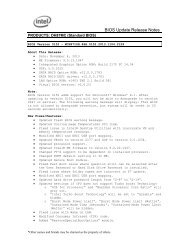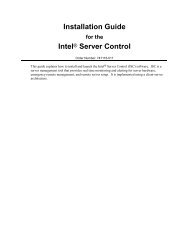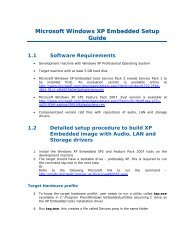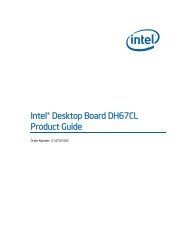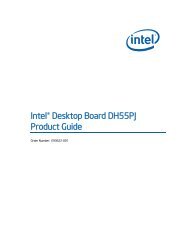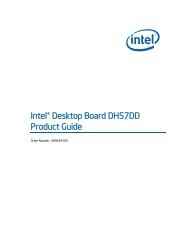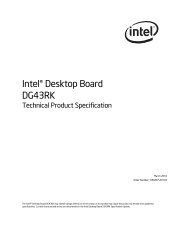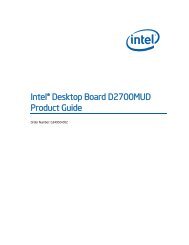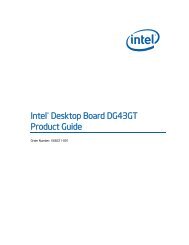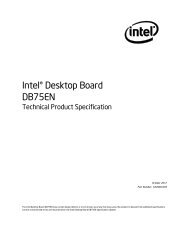Intel® Desktop Board DH61CR Product Guide
Intel® Desktop Board DH61CR Product Guide
Intel® Desktop Board DH61CR Product Guide
You also want an ePaper? Increase the reach of your titles
YUMPU automatically turns print PDFs into web optimized ePapers that Google loves.
Intel <strong>Desktop</strong> <strong>Board</strong> <strong>DH61CR</strong> <strong>Product</strong> <strong>Guide</strong><br />
Graphics Subsystem<br />
16<br />
The board supports either integrated graphics (Intel Graphics Technology) or PCI<br />
Express 2.0 x16 graphics.<br />
Integrated Graphics<br />
The board supports integrated graphics through the Intel ® Flexible Display Interface<br />
(Intel ® FDI) for processors with Intel Graphics Technology.<br />
Analog Display (VGA)<br />
The VGA port supports analog displays. The maximum supported resolution is 2048 x<br />
1536 (QXGA) at a 75 Hz refresh rate. The VGA port is enabled for POST whenever a<br />
monitor is attached, regardless of the DVI-D connector status.<br />
Digital Visual Interface<br />
Intel <strong>Desktop</strong> <strong>Board</strong> <strong>DH61CR</strong> supports Digital Visual Interface (DVI) displays with a<br />
DVI-D back panel port.<br />
The DVI-D port supports only digital DVI displays. The maximum supported resolution<br />
is 2048 x 1536 at a 75 Hz refresh rate (QXGA). The DVI-D port is compliant with the<br />
DVI 1.0 specification.<br />
PCI Express* x16 Graphics<br />
Intel Core i7, Intel Core i5, Intel Core i3, and Intel Pentium processors in an LGA1155<br />
package support discrete add-in graphics cards via the PCI Express 2.0 x16 add-in<br />
card connector. The board supports the following PCI Express speeds:<br />
• PCI Express 2 frequency of 2.5 GHz which results in 5.0 Gb/s in each direction<br />
(500 MB/s) per lane. The maximum theoretical bandwidth on the interface is<br />
8 GB/s in each direction, simultaneously, when operating in x16 mode.<br />
• PCI Express 1 frequency of 1.25 GHz resulting in 2.5 Gb/s each direction<br />
(250 MB/s) per lane. The maximum theoretical bandwidth on the interface is<br />
4 GB/s in each direction, simultaneously, when operating in x16 mode.



